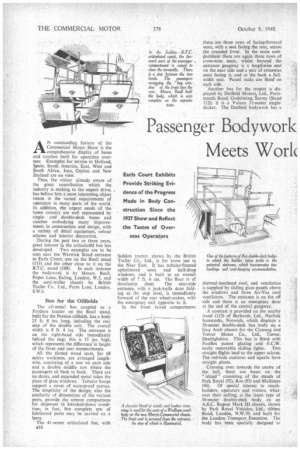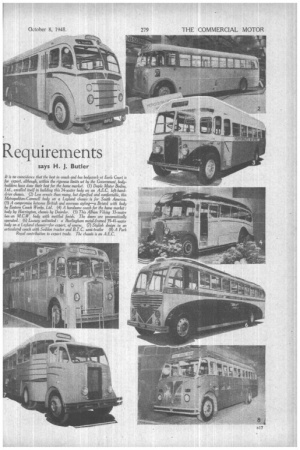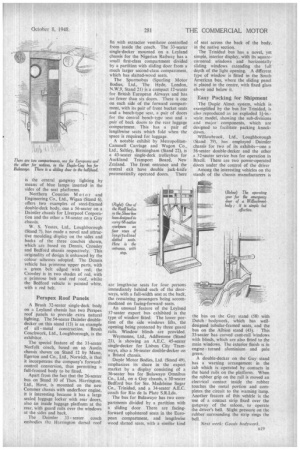Passenger Bodywork Meets Work Requirements
Page 50

Page 51

Page 52

Page 53

If you've noticed an error in this article please click here to report it so we can fix it.
says H. J. Butler AN outstanding feature of the Commercial Motor Show is the comprehensive display of buses and coaches built for operation overseas Examples for service in Holland, Spain, South America. East, West and South Africa, Iran, Ceylon and New Zealand are on view.
Thus, the visitor already aware of the great contribution which the industry is making to the export drive; has before him a most interesting object lesson in the varied requirements of operators in many parts of the world. In addition, the urgent needs of the home country are well represented by singleand double-deck buses and coaches embodying many improvements in construction and design, with a variety of detail equipment, colour scheme and interior decoration.
During the past two or three years, great interest in the articulated bus has developed. Two examples are to be seen near the Warwick Road entrance to Earls Court, one on the Rea11 stand (111) and the other close to it on the B.T.C. stand (108). In each instance the bodywork is by Messrs. ReaII, Popes Lane, Ealing, London, W.5, and the semi-trailer chassis by British Trailer Co. Ltd., Farm Lane. London. S.W.6.
Bus for the Oilfields The all-metal bus coupled to a Fordson tractor on the Reali stand. built for the Persian oilfields, has a body 25 ft. 8 ins. long, including the rear step of the double exit. The overall width is 8 ft. 4 ins. The entrance is on the right-hand side immediately behind the step; this is 15 ins, high, which represents the difference in height of the front and rear compartments.
All the slatted wood scats, for 68 native workmen, are arranged lengthwise, consisting of a row on each side and a double middle row where the passengers sit back to back. There are no doors, and expanded metal takes the place of glass windows. Tubular hoops support a cover of waterproof canvas. The simplicity of the design, also the similarity of dimensions of the various parts, provide the utmost compactness for shipment in knocked-down condition; in fact, five complete sets of fabricated parts may be carried on a lorry.
The 4I-seater articulated bus, with B16 Seddon tractor, shown by the British Trailer Co., Ltd., is for town use in the Near East. It has tubular-framed upholstered seats and half-drop windows, and is built to an Overall width of 7 ft. 6 ins. The floor is of duralumin sheet The near-side entrance, with a jack-knife door folding at the step level, is immediately forward of the rear wheel-arches, with the emergency exit opposite to it.
In the front taised compartment • there are three rows of facing-forward seats, with a seat facing the rear, across the rounded front. In the main compartment there are again three rows of cross-wise seats, whilst beyond the entrance gangway is a lengthwise seat on the near side and a pair of crosswise seats facing it, and at the back a fullwidth seat. Parcel racks are fitted on each side.
'Another bus for the tropics is displayed by Duffield Motors, Ltd., Portsmouth Road, Godalming, Surrey (Stand 112); it is a Vulcan 31-seater singledecker. The Duffield bodywork has a
thermal-insulated roof, and ventilation is supplied by sliding glass panels above the windows and three Air-Vac roof ventilators. • The entrance is on the off side and there is an emergency door at the end of the central gangway.
A contrast is provided on the nearby stand (113) of Barhards, Ltd., Norfolk Ironworks, Norwich, which displays a 56-seater double-deck bus body on a Guy Arab chassis for the Clynnog and Trevor Motor Co., Ltd., Trevor, Denbighshire. This bus is fitted with Fastflex patent glazing and E.C.W.
easily removable sliding lights. Two straight flights lead to the upper saloon. The red-hide cushions and squabs have straight pleats.
Crossing over towards the centre of the hall, there are buses on the " island " consisting of the stands of Park Vtoyal (92), Roe (93) and Mulliners (94). Of special interest to coachbuilders, operators and visitors, whatever their calling, is the latest type of 56-seater double-deck body on an A.E.C. Regent Mark III chassis, -shown by Park Royal Vehicles, Ltd., Abbey Road, London, N.W.10, and built for the London Transport Executive. The body has been specially designed to
facilitate maintenance. Precision tooling has been used to ensure interchangeability of parts.
The framework is of wood and metal, and the rear platform is supported from the body, and not on cranked extensions of the chassis. The upper-saloon roof is of Jicwood one-piece construction. A sliding door is fitted to the driver's eab. Another 56-seater double-decker on this stand is of metal construction and has been built for South Western Omnibus Co.. Ltd., Colombo, Ceylon.
Accent on Size
Rigid single-deckers and coaches having overall dimensions similar to those of articulated passenger vehicles are prominent at the exhibition. Park Royal shows in addition to home and export double-deckers a 37-seater singledeck body of metal construction mounted on an A.E.C. Regal Mark III 20-ft.-wheelbase chassis with left-hand steering.
This bus has two off-side doorways, one for entrance and the other for exit, each being of the electro-pneumatic double half-folding type extending to the step level and operated by Peters differential gear. The emergency door is opposite the central doorway.
There is much variety in the seating plans of these lengthy buses. In this instance the front half of the saloon has six crosswise seats on the left and on the right a lengthwise seat for two persons next to the front exit, behind which is a pair of crosswise seats. Beyond the central entrance there is on each side a pair of lengthwise seats, then two pairs of crosswise seats and at the back a seat extending for the full width of the bus.
On the next stand (93) of Charles H. Roe. Ltd., Crossgates, Leeds, are again two 56-seater double-deckers for Oldham and Nottingham Corporations respectively, also a single-decker for export. Among the many interesting features of the double-deckers is the Roe patented staircase incorporating two passing platforms or landings with coat-hanging accommodation below. The 30-seater with left-hand steering is based on a Guy Vixen chassis.
Mulliners, Ltd., Bordesley Green Road, Birmingham, 8 (Stand 94), has on view a Bedford 31-seater single-deck service bus. This Mulliner body is of metal-frame construction, with a sliding front entrance door and an emergency door at the rear. The cab floor is of aluminium alloy sheet. The main
B18
saloon floor may be of similar material if desired.
On Stand 95 of Northern Coachbuilders, Ltd., Newcastle-on-Tyne, one may compare the normal and lowheight types of double-decker, the former being a Sunbeam 70-seater trolleybus and the latter a 53-seater based on an A.E.0 chassis.
Teak framing has been used by J. Brockhouse and Co., Ltd., Victoria Works, Hill Top, West Bromwich (Stand 91), for a 36-seater single-deck body mounted on an Albion chassis for Accra municipal bus service, Gold Coast. This bus has two near-side doorways, both with folding doors. There are horizontally sliding glass panels above the main windows, a type of ventilation now much in favour.
Windovers, Ltd., 33, Sloane Street, London, S.W.1 (Stand 89), has produced two coach bodies of distinctive design, each with the front wing formation carried across on to the door and body panels.
John C. Beadle (Coachbuilders), Ltd., LoWfield Street, Dartford, Kent (Stand 67), has the only chassisless bus in the Show. It is a 40-seater single-decker of neat appearance and is of light-alloy construction. It employs a Sentinel underfloor engine and other components, and was described in "The Commercial Motor" on September 17. The arrangement of the power unit allows not only extra room for seating, hut provides space for a wide front entrance with a door hinged to the front bulkhead opening forward.
Strachans Successors, Ltd., Wales Farm Road, London, W.3 (Stand 3). has made news by building a 48-seater single-decker full-fronted body; it is on an Albion chassis. This bus has front and rear entrances and a rear emergency window. The large seating capacity is made possible by providing nine nearside seats, each for two persons, and nine off-side seats' each for three persons, a lengthwise seat accommodating three passengers and a seat for five across the back panel of the bus.
The window design of the Strachans 32-seater body on the Crossley export chassis should be noted. The windows are of extra width and each has a pair of sliding panels in the upper part.
The display of Plaxtons (Scarborough), Ltd., Castle Works. Scarborough (Stand 5), acquires special interest by the use of the new Commer 32-seater underfloor-engined chassis" for a coach with a large single-panel Sunsaloon roof. The seating plan includes a pair of facing-forward seats between( the entrance and driving compartment. The Foden and Dennis 32-seater coaches have a large spare-wheel and tool lockers under the floor on the near side.
Another new chassis—the MorrisCommercial—has been employed by Wadham Bros., Ltd , 97-99. London Road, Waterlooville, Hants (Stand 17), for a 31-seater coach with a central entrance enclosed by a sliding door. A Weathershields sliding roof in two portions is fitted, also a Radiomobile wireless set with extension speakers and " intercomm." with driver's microphone and speaker. There is luggage accommodation both at the rear and in the driving compartment.
A 11-decker
James Whitson and Co., Ltd., Sipson, West Drayton, Middlesex (Stand 15). shows a 29-seater full-fronted observation coach on a Maudslay chassis. Sixteen passengers are accommodated on the "lower" deck and 13 on the short upper deck at the rea The extra-large luggage compartment is accessible from the rear. A Maudslay 26-seater coach is fitted with loudspeaker and microphone. Both vehicles have the Whitson sliding door, which, by means of a curved guide, closes flush with the body panels.
One of the longest vehicles in the Show is the 39-seater Leyland coach for long-distances travel in Buenos Aires, which is exhibited by H. V. Burlingham, Ltd., Blackpool, on Stand 14. It is 35 ft. long and 8 ft. wide. The seat backs are adjustable backwards by pressure on a pedal and brought forward again by foot pressure on a rail at the side, which has a ratchet action. There are parcel racks on each side and ample luggage accommodation tinder the floor. An unusual feature
is the central gangway lighting by means of blue lamps inserted in the sides of the seat platforms.
Northern Counties Motor and Engineering Co., Ltd., Wigan (Stand 6), offers two examples of steel-framed double-deck body, one a 56-seater on a Daimler chassis for Liverpool Corporation and the other a 54-seater on a Guy chassis.
W. S. Yeates, Ltd.. Loughborough (Stand 7), has made a novel and attractive moulding display on the sides and backs of the three coaches shown, which are based on Dennis, Crossley and Bedford chassis respectively. This originality of design is enhanced by the colour schemes adopted. The Dennis vehicle has primrose upper parts, with a green belt edged with red; the Crossley' is in two shades of red, with a primrose belt and red roof, whilst the Bedford vehicle is painted white, with a red belt.
Perspex Roof Panels
A Brush 32-seater single-deck body on a Leyland chassis has two Perspex roof panels to provide extra natural lighting. The 54-seater Daimler doubledecker on this stand (13) is an example of all metal construction. Brush Coachwork, Ltd., Loughborough, is the exhibitor.
The special feature of the 3I-seater Norfolk coach, based on an Austin chassis shown on Stand 12 by Mann. Egerton and Co., Ltd., Norwich, is that it incorporates the company's forwardcontrol conversion, thus permitting a full-fronted body to be fitted.
Apart from the fact that the 26-seater bus on Stand 10 of Thos. Harrington, Ltd., Hove, is mounted on the new Commer chassis with underfloor engine. it is interesting because it has a large sealed luggage locker with rear doors, also an inside luggage platform at the rear, with guard rails over the windows at the sides and back.
The Daimler 33 seater coach embodies the Harrington dorsal roof fin with extractor ventilator controlled from inside the coach, The 33-seater single-decker mounted on a Leyland chassis for the Nigerian Railway has a small first-class compartment divided by a partition with sliding door from a much larger second-class compartment, which has slatted-wood seats. • The Spurmobus (Spurling Motor Bodies, Ltd., The Hyde, London, N.W.9, Stand 21) is a compact I2-seater for British European Airways and has no fewer than six doors. There is one on each side of the forward compartment, with its pair of front bucket seats and a bench-type seat, a pair of doors for the central bench-type seat and a pair of back doors to the rear luggage compartment. This has a pair of lengthwise seats which fold when the space is required for luggage, A notable exhibit by MetropolitanCarnmell Carriage and Wagon Co., Ltd., Saltley, Birmingham (Stand 22), is a 43-seater single-deck trolleybus for Auckland Transport Board, New Zealand. The front entrance and the central exit have double jack-knife pneumatically operated doors. There are lengthwise seats for four persons immediately behind each of the doorways, with a full-width seat at the back, the remaining passengers being accommodated on facing-forward seats.
An unusual feature of the Leyland 37-seater export bus exhibited is the type of window fitted. The lower portion of the side windows lifts, the opening being protected by three guard rails. Window blinds are provided.
Weymanns, Ltd., Addlestone (Stand 23), is showing an A.E.C. 45-seater single-decker for Lisbon City Tramways, also a 56-seater double-decker on a Bristol chassis.
Duple Motor Bodies, Ltd. (Stand 49), emphasizes its share in the export market by a display consisting of a 36-seater bus for Bulawayo Omnibus Co., Ltd., on a Guy chassis, a 30-seater Bedford bus for Ste. Madeleine Sugar Co., Trinidad, and a 34-seater A.E.C. coach for Rio de la Plate S.R.Lda.
The bus for Bulawayo has two compartments divided by a partition with a sliding door. There are facingforward upholstered seats in the European compartment, and lengthwise wood slatted seats, with a similar kind of seat across the back of the body, in the native section.
The Trinidad bus has a novel, yet simple, interior display, with its squarecornered windows and horizontally sliding windows extending the full depth of the light opening. A different type of window is fitted in the South American bus, where the sliding panel is placed in the centre, with fixed glass above and below it.
Easy Packing for Shipment
The Duple Almet system, which is exemplified by the bus for Trinidad, is also reproduced as an exploded 14-in.scale model, showing the sub-divisions and major components, which are designed to facilitate packing .knockdown.
Willowbrook, Ltd.. Loughborough (Stand 79), has employed Daimler chassis for two of its exhibits—one a 56-seater double.decker and the other a 32-seater service bus for operation in Brazil, There are two power-operated doors under the control of the driver Among the interesting vehicles on the stands of the chassis manufacturers is the bus on the Guy stand (58) with Dutch bodywork, which has welldesigned tubular-framed seats, and the bus on the Albion stand (43). This 33-seater has curved cant-rail Windows with blinds, which are also fitted to the main windows. The exterior finish is in engine turned aluminium and pale green.
A double-decker on the Guy stand has a warning arrangement in the cab which is operated by contacts in the hand rails on the platform. When the rubber grip on the rail is moved an electrical contact inside the rubber touches the metal portion and completes the circuit to the warning lamp. Another feature of this vehicle is the use of a contact strip fixed over the gangway of the saloon, to operate the driver's bell. Slight pressure on the rubber surrounding the strip rings the bell.
Next week: Goods bodywork.




















































































































